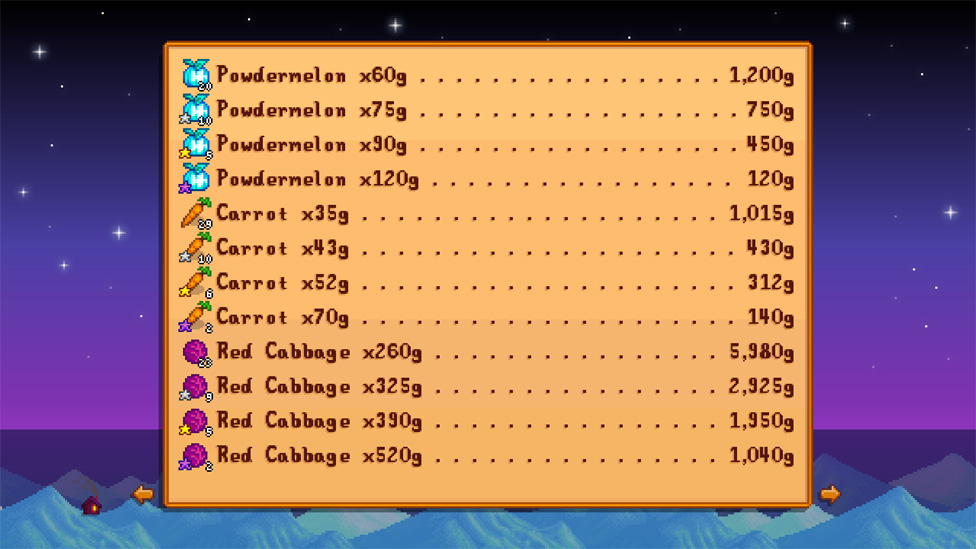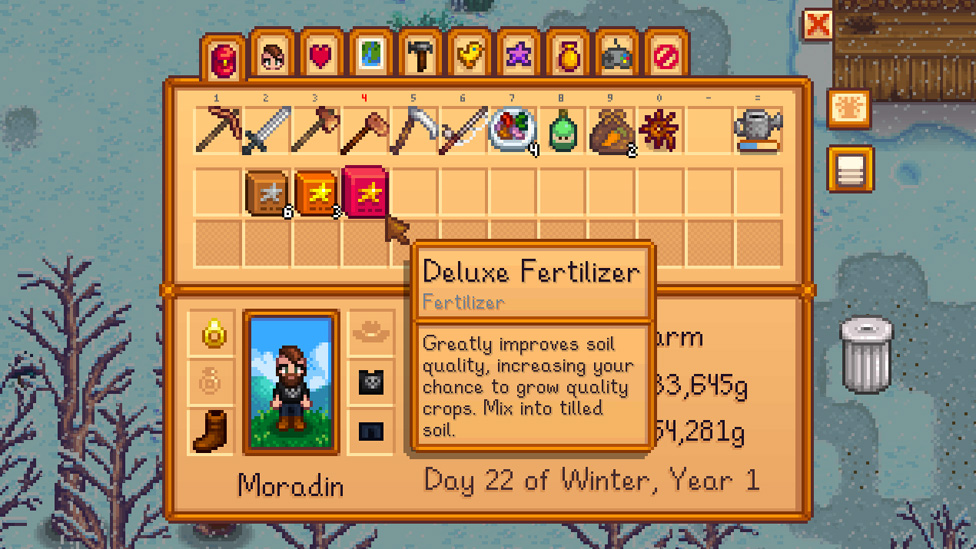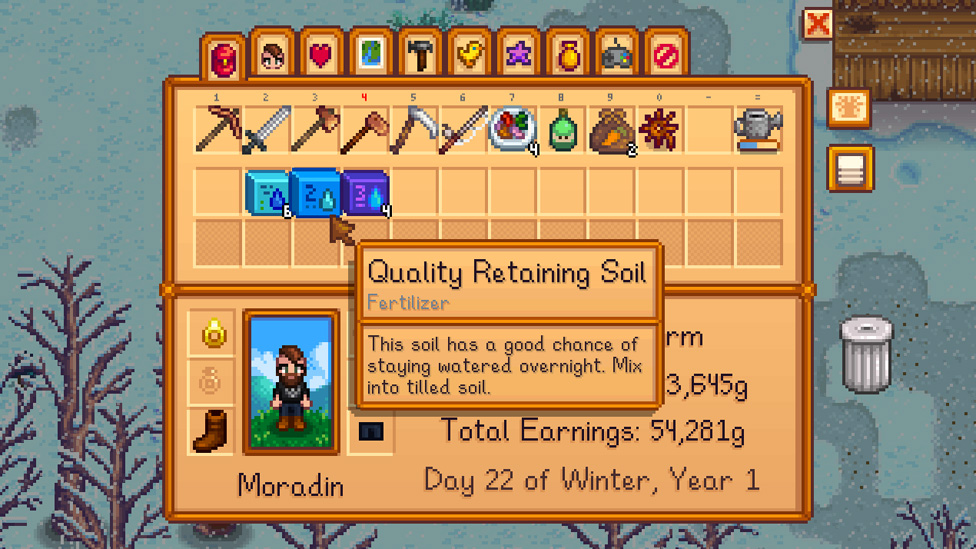Crop Quality in Stardew Valley
When it comes to growing crops in Stardew Valley, there’s a lot you’ll need to know to make sure you’re getting the right approach. After all, while you can simply plant a parsnip in the ground and hope that Stardew Valley’s random number generator looks favorably on you, this isn’t really the most efficient way to be growing crops. Following this thought, today, we’re covering some key things you should know about crop quality and growing methods in our Stardew Valley crops guide; hopefully, this will help you learn how to grow crops more successfully on your own farm, too.
Stardew Valley Crops Guide: What You Need to Know to Grow Quality Crops
Growing crops in Stardew Valley isn’t easy, but this shouldn’t have to leave you feeling lost. Fortunately, we’ve outlined some of the key things you should know about growing quality crops in Stardew Valley to help you plan your crop growing approach accordingly.

The Different Grades of Crop Quality in Stardew
There are several different quality grades for crops. Basic crops are exactly that, but higher-quality crops will be denoted with a star, indicating a higher-quality product. After standard crops, the next levels are silver, gold, and iridium, and these increase the value and energy/health benefits of the crops. For example, an iridium crop will be worth substantially more than a regular crop; for example, a regular parsnip in Stardew Valley will be worth a base of 35g, but this doubles to 70g for an iridium quality crop.
Why is Fertilizer Important in Stardew?
Before we go any further, it’s first important that we consider why fertilizer is so important in Stardew Valley. Simply put, applying fertilizer to the soil before you sow your seeds is hugely important, as it can have a significant influence on the final quality of your crops. In turn, this can vastly influence the final price of your crops, often providing a much better margin per crop than non-fertilized plants.

Understanding the Different Types of Fertilizers in Stardew Valley
There are several different types of fertilizers available in Stardew Valley, and keeping these in mind could help you decide on the right type of fertilizer for your crop growing needs.
There are three main types of fertilizer that you could use for your crops in Stardew Valley: basic fertilizer, quality fertilizer, and deluxe fertilizer. Each of these products helps improve the quality of your crops, making them valuable additions to the soil.
Basic fertilizer is the easiest type to make, requiring just two sap. Quality fertilizer, meanwhile, requires four sap and a fish (for two bags). Finally, the best fertilizer in Stardew is deluxe fertilizer, which is made from forty sap and one iridium bar (providing five bags of fertilizer).

What are Retaining Soil and Speed-Gro
As an alternative to using fertilizer for your crops, you could use retaining soil or Speed-Gro. As with fertilizer, these come in three tiers: basic, quality, and deluxe for retaining soil and basic, deluxe, and hyper for Speed-Gro.
How to Apply Fertilizer to Fields in Stardew Valley
Applying fertilizer to your tilled fields is incredibly easy; simply equip the fertilizer before planting, stand in front of the tile to be fertilized, and use the item. Each bag of fertilizer will fertilize a single tilled tile of soil, so you’ll need to stock up on quite a few bags of fertilizer to upgrade all of your fields.
Generally speaking, you can only apply fertilizer to tilled soil before any crops are planted. However, deluxe fertilizer can be applied both before and after planting. The same is also true for all varieties of Speed-Gro and retaining soil. As such, these can be used after you have planted your crops.
Will Fertilizer Expire After One Use?
Fertilizer does not expire after a single use; instead, so long as the soil remains tilled, the fertilizer will remain in the soil for the next round of crops (and so on). As such, a single bag of fertilizer could potentially last all the way from the first day of spring to the last day of fall; this helps make fertilizing your crops a lot more cost effective.
However, it’s important to keep in mind that any events causing the tilled soil to flatten will also lose the fertilizer. For example, any sudden boulders arriving that could flatten the soil or crows pecking the ground can all cause the fertilizer to run out. As such, it’s highly recommended to keep fertilized soil constantly in use, and make the most of scarecrows to ensure that crows don’t become too much of a nuisance.
Remember: while it can seem like an extra hassle in Stardew Valley to have to apply fertilizer to all of your crop fields, it can really help. So, be sure to take a little time out to apply the best fertilizer to your Stardew fields; it will reap dividends in time.
Stardew Valley Crops Guide: What You Need to Know to Grow Quality Crops
Growing crops in Stardew Valley isn’t easy, but this shouldn’t have to leave you feeling lost. Fortunately, we’ve outlined some of the key things you should know about growing quality crops in Stardew Valley to help you plan your crop growing approach accordingly.
Make Your Own Stardew Valley Server
The Different Grades of Crop Quality in Stardew
There are several different quality grades for crops. Basic crops are exactly that, but higher-quality crops will be denoted with a star, indicating a higher-quality product. After standard crops, the next levels are silver, gold, and iridium, and these increase the value and energy/health benefits of the crops. For example, an iridium crop will be worth substantially more than a regular crop; for example, a regular parsnip in Stardew Valley will be worth a base of 35g, but this doubles to 70g for an iridium quality crop.Why is Fertilizer Important in Stardew?
Before we go any further, it’s first important that we consider why fertilizer is so important in Stardew Valley. Simply put, applying fertilizer to the soil before you sow your seeds is hugely important, as it can have a significant influence on the final quality of your crops. In turn, this can vastly influence the final price of your crops, often providing a much better margin per crop than non-fertilized plants.
Understanding the Different Types of Fertilizers in Stardew Valley
There are several different types of fertilizers available in Stardew Valley, and keeping these in mind could help you decide on the right type of fertilizer for your crop growing needs. There are three main types of fertilizer that you could use for your crops in Stardew Valley: basic fertilizer, quality fertilizer, and deluxe fertilizer. Each of these products helps improve the quality of your crops, making them valuable additions to the soil.
Basic fertilizer is the easiest type to make, requiring just two sap. Quality fertilizer, meanwhile, requires four sap and a fish (for two bags). Finally, the best fertilizer in Stardew is deluxe fertilizer, which is made from forty sap and one iridium bar (providing five bags of fertilizer).

What are Retaining Soil and Speed-Gro
As an alternative to using fertilizer for your crops, you could use retaining soil or Speed-Gro. As with fertilizer, these come in three tiers: basic, quality, and deluxe for retaining soil and basic, deluxe, and hyper for Speed-Gro.How to Apply Fertilizer to Fields in Stardew Valley
Applying fertilizer to your tilled fields is incredibly easy; simply equip the fertilizer before planting, stand in front of the tile to be fertilized, and use the item. Each bag of fertilizer will fertilize a single tilled tile of soil, so you’ll need to stock up on quite a few bags of fertilizer to upgrade all of your fields.Generally speaking, you can only apply fertilizer to tilled soil before any crops are planted. However, deluxe fertilizer can be applied both before and after planting. The same is also true for all varieties of Speed-Gro and retaining soil. As such, these can be used after you have planted your crops.
Will Fertilizer Expire After One Use?
Fertilizer does not expire after a single use; instead, so long as the soil remains tilled, the fertilizer will remain in the soil for the next round of crops (and so on). As such, a single bag of fertilizer could potentially last all the way from the first day of spring to the last day of fall; this helps make fertilizing your crops a lot more cost effective. However, it’s important to keep in mind that any events causing the tilled soil to flatten will also lose the fertilizer. For example, any sudden boulders arriving that could flatten the soil or crows pecking the ground can all cause the fertilizer to run out. As such, it’s highly recommended to keep fertilized soil constantly in use, and make the most of scarecrows to ensure that crows don’t become too much of a nuisance.
FAQs
My fertilized fields keep disappearing. What can I do about it?
If your fertilized fields are disappearing, make sure you have plenty of scarecrows up and keep the plots in use at all times to prevent them from automatically returning to an untilled state.
Is high-quality Stardew Valley fertilizer worth the extra cost?
Since the recipes yield more bags of fertilizer than regular recipes, quality and deluxe fertilizers are generally worth the cost—assuming that you are able to keep the fields fertilized throughout the year.
Should I sell crop fertilizer in Stardew Valley?
Crafting fertilizers isn’t a very effective way of making money, as you will generally get less back than you would have for the raw ingredients themselves.
Final Thoughts
No matter what you’re looking to grow, from your very first parsnip in Stardew Valley to starfruits later in the game and more—knowing how crop quality works and how this influences your game is important. Luckily, we’ve outlined some key things you should know about crop quality in today’s guide to help.Remember: while it can seem like an extra hassle in Stardew Valley to have to apply fertilizer to all of your crop fields, it can really help. So, be sure to take a little time out to apply the best fertilizer to your Stardew fields; it will reap dividends in time.
Make Your Own Stardew Valley Server
Copyright 2019-2025 © ScalaCube - All Rights Reserved.